Art of the Possible in 6G – A View from 6GIC
Ning Wang, Pei Xiao, Mohsen Khalily, Fabien Heliot, Chuang Heng Foh, Yi Ma, Bernard Hunt, Rahim Tafazolli, 6G Innovation Centre (6GIC) University of Surrey
Introduction
Since the initial commercial deployment of 5G in 2019, the research community and industry have already started to outline their future 6G visions especially into the direction of blending the physical and the virtual worlds in the digitised society. While 5G will continue to evolve in the near future, there are also brand new technical challenges that will be mainly tackled in the context of 6G, e.g. ambient sensing, precision localisation and synchronisation, and manipulation of the radio propagation environment. In this article we highlight our 6G vision and some selected 6G-oriented research activities carried out at the 6G Innovation Centre (6GIC) of the University of Surrey. 6GIC will be a key UK-based hub for global innovation and collaboration on 6G wireless, involving governments, regulators, mobile operators, vendors, enterprises, and leading research and development centres, as 5GIC was for 5G innovation at the University. In this article we first outline some key features of our top-level 6G vision before diving into specific topics where a number of selected research items investigated at 6GIC are introduced.
1. Our 6G vision
We have already started to witness the potential for huge social-economic impacts from 5G, due to the cutting-edge technologies enabling new digital applications across a wide range of vertical industrial sectors. In the 6G era, as shown in Figure 1, we can further anticipate an even richer fabric of digital services, including extending human senses and ambient data blending the virtual and physical worlds. We can imagine a world where one can interact with colleagues, friends/ families and doctors from different continents, from different cultures, without any perception of not being in a common physical space with natural interactions with ambient information including all human senses. In addition, 6G is expected to have a game-changing impact on specific vertical sectors especially those involving ultra-precision control operations at large scale. In particular, we would like to emphasise the importance of ultra-precision geolocation, sensing and synchronisation capabilities in 6G in support of natural interactions as well as future mission-critical applications, some of which might not yet have been envisaged.
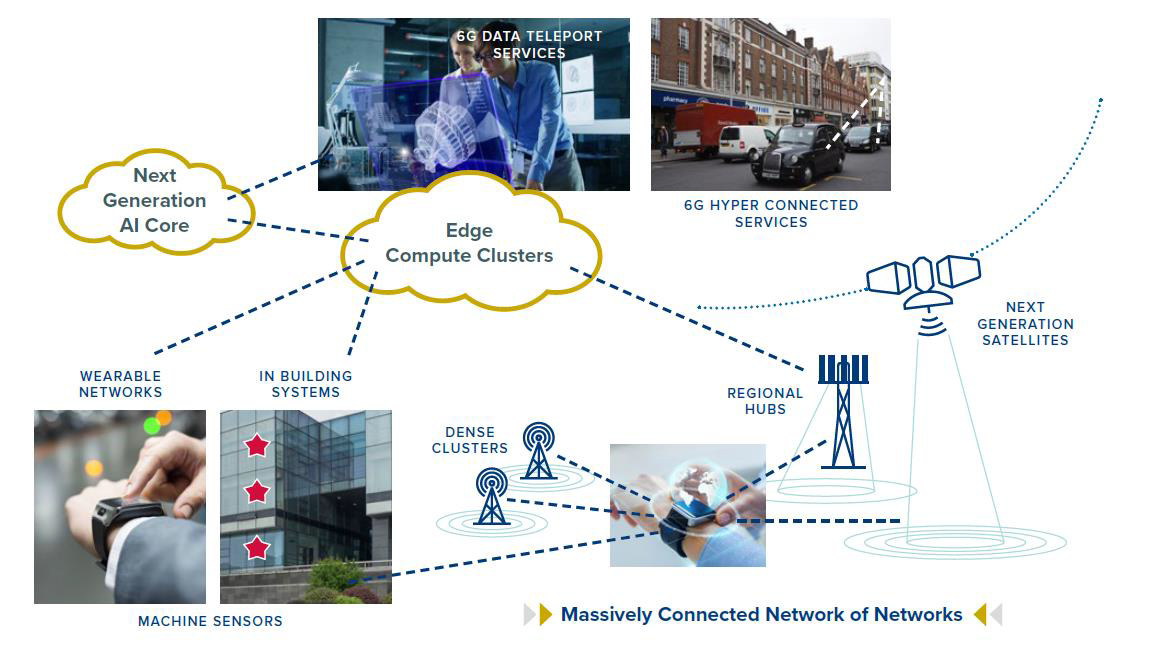
Figure 1. Our 6G vision on next generation of AI, network of networks and capabilities
It is presently difficult to predict whether the future 6G network architecture will follow a revolutionary or evolutionary pathway or a mixture of both. However, it is clear that 6G will witness the journey of network convergence as well as openness. Different types of networks bring different capabilities into the whole system: wearable and short range networks for acquisition and processing of ambient intelligence; wide area and cellular networks for mobility and capacity; and non-terrestrial networks for ubiquitous coverage and availability. It is worth mentioning that the traditional view of “network of networks” will advance into “network of capabilities” and “network of intelligence” giving that a wider variety of communication, cloud/edge computing, data storage, precise sensing/ location and software-based network functions can be integral parts of 6G supply chains. The 6G ecosystem will have the feature of deep and seamless level of capability integration, so that end users will appreciate easy and unified access to any capabilities anytime and anywhere. Ambient information and intelligence will be ubiquitous and their integration into communication infrastructure lead to smarter and energy efficient communications. We can envisage the concept of 6G consortium where stakeholders with heterogeneous capabilities can flexibly constitute a 6G system, either on a long-term basis or even on-demand. The current Open RAN concept will be naturally extended toward further openness of additional 6G components through de-aggregation of functionalities.
As far as the wireless technology is concerned, it is imperative to go beyond the ideas developed in 5G, considering the use of high definition and integrated sensing for ambient intelligence, new radio bands including THz frequencies for capacity, emerging technologies such as distributed MIMO and so-called “cell-free” concepts for resource-aware RAN architectures, and integrated satellite and terrestrial networks to support pervasive coverage. Meanwhile, materials science can enable new forms of antennas and wireless communication, including Reconfigurable Intelligent Surfaces (RIS), as well as massive and distributed antenna systems and architectures.
The full version of our 6G vision, developed in conjunction with major 6GIC industrial partners, can be found in our white paper [1].
2. 6G-related research topics
We now introduce specific dimensions of 6G-related technical challenges, as well as selected ongoing works carried out at 6GIC.
6G applications and requirements
Evolved from the 5G-oriented VR/AR, it is expected that fully immersive extended reality (XR) services such as holographic teleportation will become a killer application of 6G. We can deem teleportation as the next generation of Zoom where end users may communicate and interact with remote entities (people or objects) in a truly immersive manner, through a wide variety of human senses. The gap analysis on future network support for such applications has been investigated in the ITU Network 2030 Initiative [2] where the University of Surrey has been actively involved.
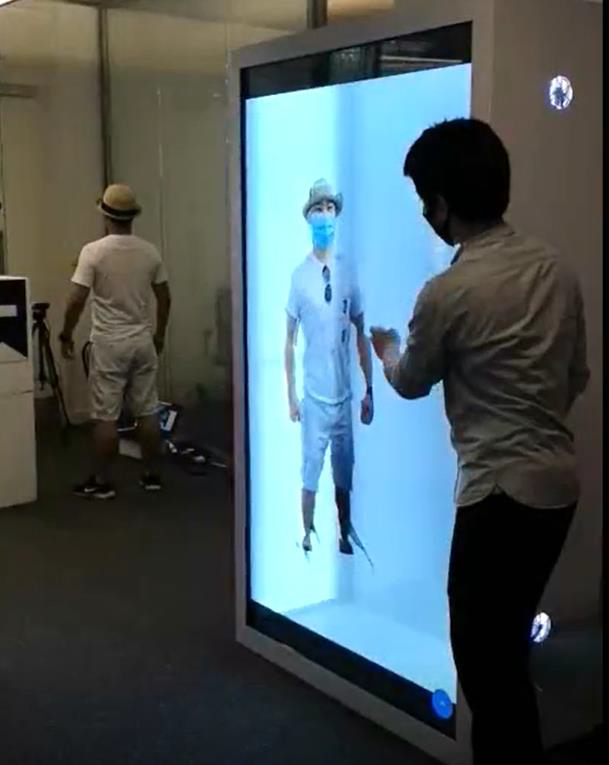
Figure 2. Real-time teleportation to human-size holographic display
Figure 2 provides a snapshot of teleportation to a holographic display. Depending on the video resolution level the data rate can be at the order of tens of Gbps according to our measurement. In addition to the ultra-high end-to-end data rate requirement for such fully immersive applications, we also envisage other technical challenges on the processing of ultra-high volume of content data at the mobile edge (e.g. remote production), as well as stringently in-time and synchronised delivery of multi-source teleportation content to end users. This is an ideal application scenario that illustrates the necessity of high-performance not only from the communication side but also (edge) computing features in future networks like 6G.
6G network architectures
Empowered by emerging technologies such as softwarisation, edge computing and network function virtualisation (NFV), 5G has become a much more open and flexible network platform capable of autonomously supporting a wider range of vertical applications compared to its predecessors. On the other hand, we still have the “fences”, in terms of necessary interfaces and gateways etc., between 5G and the outside world, known as “non-3GPP” networks, including fixed Internet, WiFi, satellite networks and cloud/fog infrastructures. One daring 6G vision is of a borderless ecosystem consisting of natively integrated capabilities contributed from heterogeneous communication, computing, storage, or even (AI-based) knowledge resources. The implication to the evolved business model is the creation of open opportunities for all types of stakeholders to be an integral part of 6G supply chains.
Specific to the integration of space networks and future 6G, we envisage satellite network segment to be a native component of the 6G ecosystem, offering not only backhaul functionalities but also direct user equipment access services. In particular, Low Earth Orbit (LEO) satellite systems will play an essential role thanks to the relatively low network latencies. Direct user equipment (UE) access to the satellite without the support of ground stations will be a key feature in 6G, allowing end users to access services even at rural areas conveniently. Meanwhile, the mega-constellation behaviours of LEO satellites will pose new research issues in terms of topology dynamicity, routing stability and optimality, as well as service continuity to end users. Similar to its terrestrial counterpart, we also look at the possibility of software defined space networks in 6G, allowing fully programmable traffic steering and service delivery tailored for specific application requirements and business policies.
6G Wireless Technologies, Reconfigurable Intelligent Surface (RIS)
An RIS is a reflecting surface capable of directing electromagnetic waves to the direction of interest as shown in Figure 3. Similar to the holographic metasurface concept [6], an RIS synthetises a radiation pattern of interest in a holographic manner [7]. The role of the RIS is to modulate the incident wave on the aperture into a desired aperture field that radiates the radiation pattern of interest. This is achieved by altering the phase of the incident wave with the phase response of each unit cell across the RIS upon reflection. As a result, an RIS can reconfigure the desired radiation pattern in an intelligent and automated manner and eliminate the need for mechanical scanning.
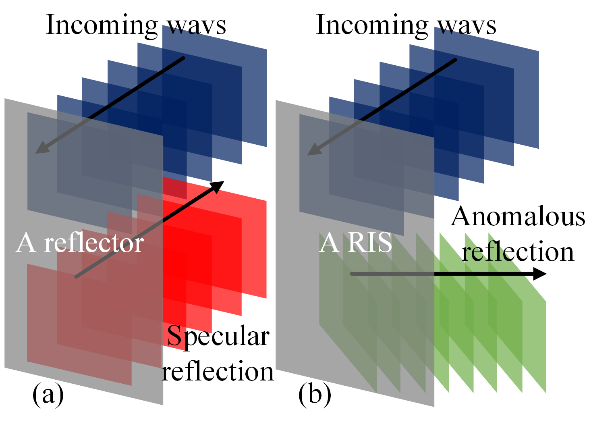
Figure 3. The mechanism of wave reflection in an RIS-enhanced environment, (a) specular reflection from a conventional reflector; (b) engineered reflection from an RIS to the desired angle.
6G networks require much higher data rate with robust and meaningful coverage. Network operators can employ THz bands to meet those requirements. However, the path loss will be dramatically increased for THz communications. As such, coverage would certainly be shrunk and remedial actions must be taken to compensate the loss. RIS will play a pivotal role in this regard where the sporadic waves in an environment can be purposefully recycled and redirected to the network’s blind spots.
The design procedure of an RIS is directly linked to the geographical properties of the region where it is going to be deployed. The location of base stations (BSs) and the direction of reflected waves will have a direct influence on the constructed pattern of unit cells within the RIS structure. Consequently, the design of an RIS should be customised for each case, which is in contradiction with mass production. One solution to sort this issue out is to equip the RIS with controlling components such as Varactor of PIN diodes to dynamically change the macroscopic response of the RIS without changing its physics. Two types of RISs have been prototyped at 6GIC, as shown in Fig. 4. The structure on the left side of Fig. is capable of dynamically changing the reflected beam, thus suita4ble to be employed in urban areas wherever beam scanning is required. Whereas, the one on the right side of Fig. 4 has fixed engineered reflected beam directions but needs no electrical power and works as a stand-alone equipment. It is thus useful either when the direction of the reflected beam does not need to be changed or the provisioning of electrical power is challenging for network operators.
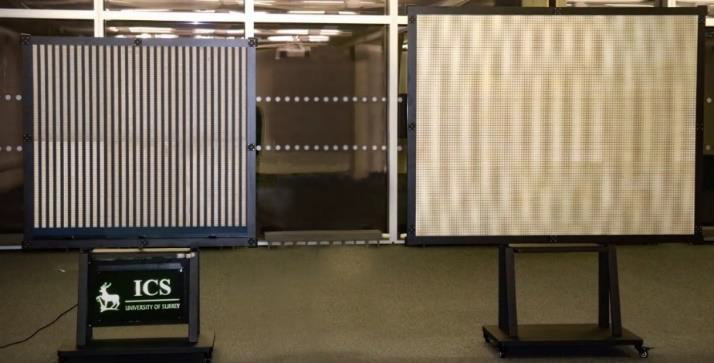
Figure 4. The world’s first RIS demo at 6GIC. The left-side one can dynamically change the beam while the one on right has fixed reflected beam with no need of electrical power.
A video of the RIS demo can be found at https://www.youtube.com/watch?v=PoLEWaDg8f4
At 6GIC, we are also studying the fundamental limits of RIS-aided multi-input multi-output (MIMO), a.k.a. MIMO-RIS, communication systems, starting from simple scenarios, e.g. point-to-point, before tackling more advanced ones, e.g. multi-user distributed MIMO/cell-free. So far, we have derived both the capacity and fundamental energy efficiency (EE)-spectral efficiency (SE) trade-off expressions for point-to-point MIMO-RIS systems. These expressions have helped us to better understand the benefit of MIMO-RIS in comparison with other MIMO based systems, e.g. classic MIMO systems, MIMO relay-based systems. Our performance analysis shows that MIMO-RIS is more spectrally efficient than both MIMO-relay and MIMO (i.e. 60% and 15% more efficient, respectively) and at least three times more energy efficient than MIMO in a point-to-point communication scenario.
We have also explored different scenarios and use cases of RIS, e.g., in the areas of security [8], RIS-aided cell-free networks [9] and RIS assisted mobile edge computing [10], etc. Those studies have demonstrated diverse applications of RIS to improve network performance KPIs in terms of spectrum efficiency, energy efficiency, deployment efficiency and secrecy.
THz Communications for 6G:
Even though 5G systems are still being rolled out, it is argued that their rates, in the order of gigabits per second, may fall short at supporting many emerging applications, such as 3D gaming and extended reality. Such applications may require data rates of several hundreds of gigabits to several terabits per second with low latency and high reliability, which may be expected to be requirements of 6G. Given the potential of terahertz (THz) communications systems to provide such data rates over short distances, they are widely regarded to be the next frontier for wireless communications research.
However, the following major technical challenges need to be addressed in order to render THz viable for practical deployments. 1) its short communication range due to high propagation and molecular absorption losses; 2) THz transceiver design: the frequency band of the THz signal is too high for conventional oscillators, while it is too low for optical photon emitters. This problem is known as the THz gap; 3) Antenna and amplifier design for ultra-wideband THz transmissions; 4) THz beam tracking: the main challenge is how to acquire channel state information. It is crucial to accurately measure the angle of departure (AoD) of transmitters and the angle of arrival (AoA) of receivers by using beam tracking techniques.
At 6GIC, we have conducted research on several enabling technologies for THz communications. In [11], we designed a high gain on-chip antenna on silicon technology for sub terahertz applications over a wide-frequency range. An efficient terahertz (THz) photoconductive antenna (PCA) was proposed in [12]. The antenna is designed for continuous wave (CW) applications in the frequency range of 0.5-3 THz. The overall optical-to-THz efficiency of the proposed PCA is improved by enhancing the optical-to-electrical and radiation efficiencies. In [13], a novel terahertz (THz) spectroscopy technique and a new graphene-based sensor were proposed. It is the first THz sensor of its kind. A terahertz sensor structure was proposed in [14] that is capable of sensing any variations in physical properties of materials.
Our next step is to design spectrum and power efficient multi-carrier waveform for THz communication by leveraging visible light communication (VLC) and ultra-wide band (UWB) waveform designs, taking into consideration practical limitations. Based on the literature, the vast majority of experimental transceivers designed for THz band (0.3 to 3 THz) rely on optical communication with intensity modulation (IM)/direct detection (DD) being the common method for transmitting/detecting the waveforms. This makes pulse-based and optical multi-carrier waveform designs very relevant to THz communication. Another important aspect of the THz band is that molecular absorption, e,g, water vapor, plays a significant role in the waveform propagation. As such, the available transmission bandwidth varies as a function of the transmission distance, with the channel acting as a band-pass filter, i.e. creating transmission windows, for transmission distance greater than roughly half a meter for a standard environment. This effect requires the design of adaptive waveforms, where their shape is adapted to the transmission distance.
Meanwhile, channel modelling is a crucial element in the development of efficient and robust communication systems. In collaboration with the National Physical Laboratory (NPL) in UK, we have conducted some initial measurements over an ultra-wide bandwidth in the 500-750 GHz range to understand the behaviour of the THz channel [15], [16]. Our line-of-sight (LoS) measurements have shown the effect of molecular absorption; its induced losses in the received signal strength become more apparent as the distance between the two transmission nodes increases. We also conducted some non-line-of-sight (NLoS) measurements by placing various test materials at a specular angle between the transmitter and receiver ends and our results demonstrate the high frequency selectivity that causes clusters of diffuse components forming at the LoS peak. As the THz spectrum is currently unused and unregulated, it is also important to understand the behaviour of the propagating wave over ultra-wide bandwidths. The main challenges that needs to be addressed when modelling the channel at these frequencies over large bandwidths is the computational complexity faced by deterministic methods such as ray-tracing, i.e. the large number of lengthy measurements that are required to accurately and empirically characterise the propagation channel.
Cell-free Massive MIMO
Cell-free massive MIMO provides a new user-centric and scalable networking architecture for 6G. In Cell-free networks, such as that shown by Figure 5, communications functions are moved to the distributed network edge, implementing user-centric transmissions to overcome the inter-cell interference limitation in 4G and 5G cellular networks. Each user is served by coherent joint transmission from its selected subset of APs (user-specific cluster). This approach eliminates cell edge effects, resulting in more uniform user experience.

Figure 5. A cell-free network
Figure 6 illustrates the benefits of cell-free massive MIMO in terms of spectral efficiency performance (in bits/s/Hz) at different locations in an area with nine APs. The left-hand figure shows that the performance of cell-edge users is very poor in conventional cellular massive MIMO whereas the right-hand figure shows that cell-free massive MIMO provides almost uniform spectral efficiency thanks to the distributed APs.

Figure 6. Left: cellular network. Right: cell-free massive MIMO network. Spectral efficiency achieved by users at different locations in an area covered by nine APs that are deployed on a regular grid.
In [19], we studied cell-free massive MIMO systems with limited-capacity front-haul which is the link between each access point and edge processing unit (EPU), and proposed deep convolutional neural network (DCNN) to solve the rate maximisation problem, leading to 70% improvement in sum data rate. In [20], the energy efficiency maximisation problem in cell-free massive MIMO system was investigated taking into account the effects of channel estimation error and quantisation distortion. We decoupled the original problem into two sub-problems, namely, receiver filter coefficient design, and power allocation. An iterative algorithm was proposed to alternately solve each sub-problem. The proposed scheme achieves 60% energy saving compared to conventional equal power allocation. In [21], we investigated the performance of the RIS-aided cell-free massive MIMO system. A novel optimisation scheme was developed. The simulation results demonstrated the superiority of the proposed scheme in terms of maximising the minimum rate of the users compared with the state-of-the-art schemes and 70% improvement in spectrum efficiency compared to the case without RIS.
6G intelligence
So far we have experienced the initial feature of network intelligence in the 5G paradigm, and there is no doubt that the intelligence capability will be further developed into the 6G era with future advancement of artificial intelligence, in particular machine learning (ML) technologies. As mentioned earlier, we envisage consortium-like 6G ecosystems that may flexibly consist of resources provided from different autonomous stakeholders. In this scenario, the resources supplied by different providers are typically managed by specific intelligence or policies from their own owners. Individual stakeholders may have their own business and operational intent, and the corresponding decision-making processes may heavily rely on individually tailored AI algorithms. This is in contrast to the current 5G scenario where an AI-based orchestration function can be fulfilled by a centralised orchestrator across multiple local control agents in different parts of a common network infrastructure, including RAN, transport and core network segments. In the case of multi-stakeholder scenario, intent and behaviours of individual players may interfere with each other in highly dynamic conditions. As such, multi-agent based AI solutions for prediction, detection and resolution of conflicts, in a fully distributed fashion, will be required in order to strike the best trade-off between global optimality (including end-to-end performance assurances) and local business/operation intent. The current intent-based networking (IBN) framework can be deemed as a promising starting point towards such an advanced scenario.
6G RANs will be more complex than earlier generations of RANs and, thus, automation will be required to achieve zero-touch operation. Automation in RAN can be achieved by utilising self-organising network (SON) techniques. Many existing SON designs rely on a rule-based approach to achieve automation. The recent wide spread use of ML techniques in communication has reached SON, where ML-based SON approaches have recently been designed for 5G. The existing ML-based solutions for SON often focus on applying a specific ML technique to automate a certain aspect of SON such as fault detection or self-healing [22]. We expect this trend to carry on beyond 5G. In 6G, with the accumulation of knowledge and experiences in individual ML-based SON design gained in 5G, we foresee that the main focus in SON research will be the convergence and consolidation of various ML algorithms into a single AI-framework that can achieve single-best non-conflicting decision making.
Last but not least, 6G radio technologies will be extremely demanding in terms of spectral efficiency, energy efficiency, reliability, and latency. These are making future wireless systems nonlinear, non-stationary, non-Gaussian, and non-ergodic (called 4N-Wireless). Design and optimisation of 4N-Wireless systems is fundamentally very challenging because there is no general theory available to this date that can handle such complex optimisation problems, and this is where AI and ML can play a central role. For instance, the autoencoder technique can be a useful tool for end-to-end wireless link optimisation, which does not need a trackable communication system model. The recurrent neural network (RNN) can be useful to solve many system reverse problems (such as MIMO precoding, channel equalisation, power amplifier linearisation, etc.) in 4N-Wireless systems. Moreover, AI can help to predict wireless channel changes and enable accurate radio resource scheduling and planning. For example, a deep convolutional neural network (DCNN) was exploited in [19] to optimize the power control in cell-free massive MIMO network. Overall, we expect AI/ML to become essential to 6G radio technologies.
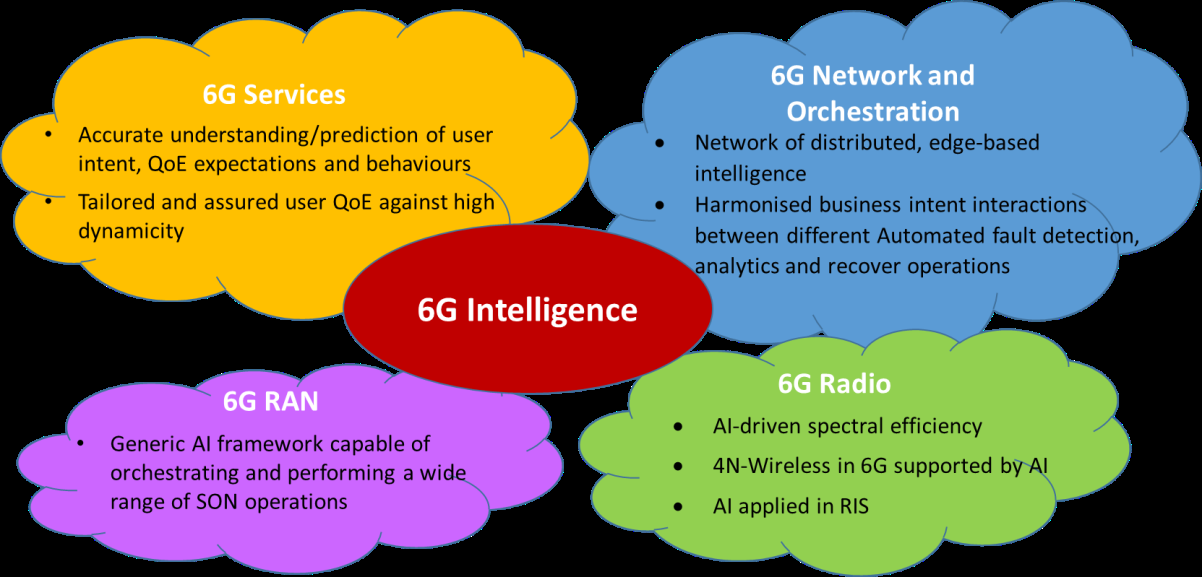
Figure 7. Applications of 6G Intelligence
3. Summary
In this article we highlighted our vision on future 6G networks from 6GIC hosted at the University of Surrey. We specifically elaborated in detail different facades of 6G, including 6G applications, network architectures, emerging radio technologies as well as new 6G intelligence. We also take this opportunity to highlight some of our ongoing work in the context of 6G research. Table 1 provides a summary on key 6G challenges and potential solutions or enabling technologies we have envisaged.
| Challenges | Potential Solutions | |
| 6G applications and requirements | - Blending physical and virtual worlds - Fully immersive eXtended Reality (XR) including Holographic Teleportation |
- Pervasive network availability - Beyond Gbps data rate - Ambient and user sensing - Ultra-precise localisation and synchronisation |
| 6G network architectures | - Seamless Integration of heterogeneous networks and capabilities | - New 6G architectures with open and flexible network capability integration |
| - Unified and direct UE access of connectivity | - New space-terrestrial network integration | |
| - Inconsistent network performance at cell-edge due to interference | - Cell-free network architecture | |
| 6G wireless technologies | - Unfavourable propagation environment at higher frequencies | - Reconfigurable Intelligent Surfaces to manipulate the physical environment |
| - Nonlinear, non-stationary, non-Gaussian, and non-ergodic wireless systems (4N-wireless) | - AI/ML applied to wireless signal processing | |
| 6G network and resource management | - Zero-touch network control and management in complex environments - Advanced intent-based network management paradigms |
- Harmonising co-existing stakeholders and players in the 6G - Distributed AI framework |
Table 1. Summary 6G technical challenges and potential solutions
While it is too early to predict whether the realisation of future 6G will follow in an evolutionary or revolutionary fashion, or a mixture, we have already identified some key enabling technologies and future directions as elaborated in this article.
References
[1] 5/6G Innovation Centre, “6G Wireless – A New Strategic Vision”, https://www.surrey.ac.uk/sites/default/files/2020-11/6g-wireless-a-new-strategic-vision-paper.pdf
[2] ITU Network 2030 white paper “A Blueprint of Technology, Applications and Market Drivers Towards the Year 2030 and Beyond”, https://www.itu.int/en/ITU-T/focusgroups/net2030/Documents/White_Paper.pdf
[6] Araghi, M. Khalily, P. Xiao, and R. Tafazolli, “Holographic-based leaky-wave structures: Transformation of guided waves to leaky waves,”IEEE Microwave Magazine, vol. 22, no. 6, pp. 49–63, 2021.
[7] A. Araghi, M. Khalily, P. Xiao, R. Tafazolli, ”Holographic-based mmw-wideband bidirectional frequency scanning leaky wave antenna,” in 14thEuropean Conference on Antennas and Propagation (EuCAP), 2020.
[8] Zheng Chu, et. al. “Intelligent Reflect Surface Aided Multi-antenna Secure Transmission”. IEEE Wireless Communications Letters, vol. 9, no. 1, pp. 108-112, Jan. 2020.
[9] Zheng Chu, et. al. "Secrecy Rate Optimization for Intelligent Reflecting Surface Assisted MIMO System". IEEE Transactions on Information Forensics and Security, vol. 16, pp. 1655-1669, Nov. 2020.
[10] Zheng Chu, et. al. “Intelligent Reflecting Surfaces Enabled Cognitive Internet of Things Based on Practical Pathloss Model’’, China Communications, vol. 17, no. 12, 2020.
[11] Manijeh Bashar, et. al. “On the Performance of Reconfigurable Intelligent Surface-Aided Cell-Free Massive MIMO Uplink”. IEEE Globecom 2020.
[12] Zheng Chu, et. al. “Intelligent Reflecting Surface Assisted Mobile Edge Computing for Internet of Things”, IEEE Wireless Commun. Lett., vol. 10, no. 3, pp. 619-623, March 2021.
[13] M. Alibakhshikenari et al., "High-Gain On-Chip Antenna Design on Silicon Layer With Aperture Excitation for Terahertz Applications," in IEEE Antennas and Wireless Propagation Letters, vol. 19, no. 9, pp. 1576-1580, Sept. 2020, doi: 10.1109/LAWP.2020.3010865.
[14] S. B. Amlashi, M. Khalily, T. Brown, P. Xiao and R. Tafazolli, "An Efficient Plasmonic Photoconductive Antenna for Terahertz Continuous-Wave Applications," 2021 15th European Conference on Antennas and Propagation (EuCAP), 2021, pp. 1-5, doi: 10.23919/EuCAP51087.2021.9410902.
[15] S. B. Amlashi, M. Khalily, V. Singh, P. Xiao, J. D. Carey and R. Tafazolli, "Surface Electromagnetic Performance Analysis of a Graphene-Based Terahertz Sensor Using a Novel Spectroscopy Technique," in IEEE Journal on Selected Areas in Communications, vol. 39, no. 6, pp. 1797-1816, June 2021, doi: 10.1109/JSAC.2021.3071835.
[16] Niknam S, Yazdi M, Behboudi Amlashi S and Khalily M (2020) Numerical Performance Analysis of Terahertz Spectroscopy Using an Ultra-Sensitive Resonance-Based Sensor. Front. Phys. 8:19. doi: 10.3389/fphy.2020.00019.
[17] D. Serghiou, Mohsen Khalily et al., "Ultra-Wideband Terahertz Channel Propagation Measurements from 500 to 750 GHz," 2020 International Conference on UK-China Emerging Technologies (UCET), Glasgow, United Kingdom, 2020, pp. 1-4,
[18] D. Serghiou, Mohsen Khalily, et al., "Comparison of Diffuse Roughness Scattering from Material Reflections at 500-750 GHz," 2021 15th European Conference on Antennas and Propagation (EuCAP), 2021, pp. 1-5.
[19] M. Bashar, et. al. “Exploiting Deep Learning in Limited-Fronthaul Cell-Free Massive MIMO Uplink,” IEEE JSAC special issue on Multiple Antenna Technologies for Beyond 5G, vol. 38. no. 8, August 2020.
[20] M. Bashar, et. al. “Energy Efficiency of the Cell-Free Massive MIMO Uplink with Optimal Uniform Quantization,” IEEE Transactions on Green Communications and Networking, vol. 3, no. 4, Dec. 2019.
[21] M. Bashar, et. al. “On the Performance of Reconfigurable Intelligent Surface-Aided Cell-Free Massive MIMO Uplink”. IEEE Globecom 2020.
[22] Mulvey, et al. "Cell Fault Management Using Machine Learning Techniques," IEEE Access, vol. 7, pp. 124514-124539, 2019.
Subscribe to Tech Focus
Join our IEEE Future Networks Technical Community and receive IEEE Future NetworksTech Focus delivered to your email.
Article Contributions Welcome
Submit Manuscript via Track Chair
Author guidelines can be found here.
Other Future Networks Publications
IEEE Future Networks Tech Focus Editorial Board
Rod Waterhouse, Editor-in-Chief
Mithun Mukherjee, Managing Editor
Imran Shafique Ansari
Anwer Al-Dulaimi
Stefano Buzzi
Yunlong Cai
Zhi Ning Chen
Panagiotis Demestichas
Ashutosh Dutta
Yang Hao
Gerry Hayes
Chih-Lin I
James Irvine
Meng Lu
Amine Maaref
Thas Nirmalathas
Sen Wang
Shugong Xu
Haijun Zhang
Glaucio Haroldo Silva de Carvalho

